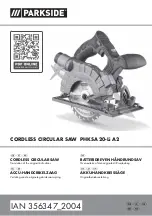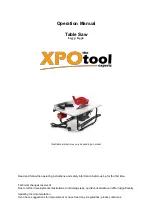
Position your body and hands prop-
erly to make cutting easier and
safer. Observe the following instructions (Figure 17).
Figure 17. Hand Positions
●
Never place hands near cutting area. Keep hands
and arms outside the “No Hands” zone.
●
The “No Hands Zone” is defined as the entire Table
plus the fixed portion of the Base on the right and
left side of the Table and portions of the Fence
within this boundry. This zone is labeled by “No
Hands” symbols placed on the fixed Base.
●
Be aware of the path of the sawblade. Make a dry
run with the saw OFF by conducting a simulated
cutting cycle, and observe the projected path of the
sawblade. Keep hands out of the path of sawblade.
DRY RUN—
It is important to know where the blade
will intersect with the workpiece during cutting oper-
ations. Always perform the simulated cutting
sequence with the power tool switched OFF to gain
an understanding of the projected path of the saw-
blade. Mentally note where the path of sawblade
will fall and set up your work to keep your hands
and arms out of the path of the spinning blade.
Adjust your clamps and fences so that the smooth
lower guard and cutting action is not interfered with
during cutting operation.
●
Hold workpiece firmly against table and fence to
prevent movement.
●
Keep hands in position until trigger has been
released and blade has stopped completely.
●
Never place hands on slide rails.
●
Keep feet firmly on the floor and maintain proper
balance.
●
Follow the miter arm when mitering left or right.
Stand slightly to the side of the saw blade.
The lower guard may not automatically
open under certain cutting conditions.
For example, when trying to cut work-pieces that are
near the maximum cutting height capacity. Under
these conditions or during the sliding motion of cut,
the workpiece can stop the lower guard movement
before the downward motion of the arm could pre-
open the lower guard.
If this occurs:
●
Workpiece must be securely clamped. This frees a
hand to raise the guard by the lip just
enough to clear the workpiece (Figure 18).
●
Start the saw and begin your cut.
●
Once you have cleared the position where the
lower guard may bind, release the guard and it will
continue to operate automatically as you cut.
Figure 18. Raising Lower Guard
19.
Basic Saw Operations
Body and Hand Position
WARNING
!
WARNING
!
Lip
Lower
Guard
Workpiece
Correct
Incorrect Use
Projected Line Of Cut
Содержание 5412L
Страница 110: ...110 Notes ...
Страница 111: ...111 Notas Remarques ...
















































